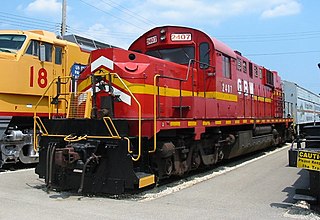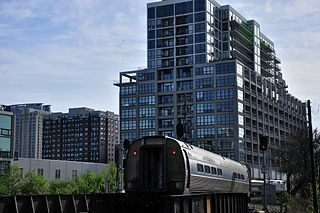
Stockton is a village in Jo Daviess County, Illinois, United States. The population was 1,862 at the 2010 census, down from 1,926 at the 2000 census.

The Chicago, Burlington and Quincy Railroad was a railroad that operated in the Midwestern United States. Commonly referred to as the Burlington Route, the Burlington, or as the Q, it operated extensive trackage in the states of Colorado, Illinois, Iowa, Kansas, Kentucky, Missouri, Montana, Nebraska, Wisconsin, Wyoming, and also in New Mexico and Texas through subsidiaries Colorado and Southern Railway, Fort Worth and Denver Railway, and Burlington-Rock Island Railroad. Its primary connections included Chicago, Minneapolis–Saint Paul, St. Louis, Kansas City, and Denver. Because of this extensive trackage in the midwest and mountain states, the railroad used the advertising slogans "Everywhere West", "Way of the Zephyrs", and "The Way West".

The Chicago Great Western Railway was a Class I railroad that linked Chicago, Minneapolis, Omaha, and Kansas City. It was founded by Alpheus Beede Stickney in 1885 as a regional line between St. Paul and the Iowa state line called the Minnesota and Northwestern Railroad. Through mergers and new construction, the railroad, named Chicago Great Western after 1892, quickly became a multi-state carrier. One of the last Class I railroads to be built, it competed against several other more well-established railroads in the same territory, and developed a corporate culture of innovation and efficiency to survive.

The Green Bay and Western Railroad served central Wisconsin for almost 100 years before it was absorbed into the Wisconsin Central in 1993. For much of its history the railroad was also known as the Green Bay Route. At the end of 1970 it operated 255 miles of road on 322 miles of track; that year it reported 317 million ton-miles of revenue freight.

The Chicago and North Western Transportation Company was a Class I railroad in the Midwestern United States. It was also known as the "North Western". The railroad operated more than 5,000 miles (8,000 km) of track as of the turn of the 20th century, and over 12,000 miles (19,000 km) of track in seven states before retrenchment in the late 1970s. Until 1972, when the employees purchased the company, it was named the Chicago and North Western Railway.

The BNSF Railway Line is a Metra commuter rail line operated by the eponymous freight railroad in Chicago and its western suburbs. In 2010, the BNSF Railway Line continued to have the highest weekday ridership of the 11 Metra lines. While Metra does not refer to its lines by particular colors, the BNSF line's color on Metra timetables is "Cascade Green," a nod to the paint of the Burlington Northern Railroad. In July 2017, the public timetable showed 47 trains leaving Chicago each weekday, of which 31 run to Aurora. Of the 16 trains that do not reach Aurora, 5 terminate at Route 59, 1 at Naperville, 1 at Downers Grove-Main Street, 5 at Downers Grove-Fairview Avenue, 3 at Westmont, and 1 at Brookfield. The public timetable also showed 47 trains arriving in Chicago each weekday, of which 29 start in Aurora. Of the 18 trains that do not start in Aurora, 6 start at Lisle, 1 at Downers Grove-Main Street, 7 at Downers Grove-Fairview Avenue, 1 at Highlands, and 3 at Brookfield.
The Winston Tunnel is a railroad tunnel located 9 miles west of Elizabeth, Illinois.

The St. Charles Air Line is a rail line in Chicago, Illinois, partially owned by the BNSF Railway, Union Pacific Railroad, and Canadian National Railway.

The Pittsburgh, Cincinnati, Chicago and St. Louis Railroad, commonly called the Pan Handle Route, was a railroad that was part of the Pennsylvania Railroad system. Its common name came from its main line, which began at Pittsburgh, Pennsylvania, crossed the Northern Panhandle of West Virginia, and continued west to Bradford, Ohio, where it split into a northern line to Chicago and a southern one through Indianapolis, Indiana, to East St. Louis, Illinois.

The Kansas City Zephyr was a streamliner passenger train service operated by the Chicago, Burlington and Quincy Railroad (CB&Q) between Chicago and Kansas City.

The Toledo, Peoria and Western Railway is a short line railroad that operates 247 miles (398 km) of track from Mapleton, Illinois, through Peoria across Illinois to Logansport, Indiana. TP&W has trackage rights between Galesburg, Illinois, and Peoria, between Logansport and Kokomo, Indiana, and between Reynolds, Indiana, and Lafayette, Indiana. TPW has connections with UP, BNSF, NS, CSXT, CN, CP, CERA, CIM, KBSR and T&P. The railroad is now owned by Genesee & Wyoming Inc.

Galesburg is an Amtrak intercity train station in Galesburg, Illinois, United States. The station was originally built in 1984, after the razing of the large depot just south of the current site. It is located north of the large BNSF Classification yard. Just south the Illinois Zephyr and Carl Sandburg diverge via the Quincy main line which bypasses the yard on the east side. The California Zephyr and the Southwest Chief continue to the southwest side of Galesburg near Knox College.
The St. Croix Subdivision or St. Croix Sub is an American rail line operated by the BNSF Railway. It runs approximately 150 miles (240 km) from La Crosse, Wisconsin to Saint Paul, Minnesota, following the Mississippi River. It runs through the communities of La Crosse, Onalaska, Brice Prairie, Trempealeau, East Winona, Fountain City, Cochrane, Buffalo City, Alma, Nelson, Pepin, Stockholm, Maiden Rock, Bay City, Diamond Bluff, and Prescott, Wisconsin. This section of track sees 55-60 trains a day and is double tracked for most of the 150 miles with exceptions of Burns to Prescott, Mears to Trevino, and Winona Jct. to East Winona.

The Chicago Junction Railway operated a switching and terminal railroad in Chicago, connecting the Union Stock Yards with most other railroads in the city. It also briefly operated an outer belt, which became the Indiana Harbor Belt Railroad in 1907. The New York Central Railroad acquired control of the company in 1922 and leased it to subsidiary Chicago River and Indiana Railroad. The line is now owned and operated by the Norfolk Southern Railway.
The Chicago and Aurora Railroad was an early predecessor of the Chicago, Burlington and Quincy Railroad that built a line from West Chicago to Mendota via Aurora, Illinois.
The Galena–Chicago trail was a stagecoach route located in northern Illinois that ran from the mid-to-late 1830s until 1854. As indicated by its name, the route linked Chicago, located in the northeast of the state, with Galena which was located in the lead mining district of the northwest. The Chicago-Galena trail includes the "Stagecoach Trail" that runs between Galena and Lena, Illinois. East of Lena the stage route follows U.S. Route 20 and Business U.S. Route 20 through Eleroy, Freeport and Rockford to Belvidere. This road began as the old State Road number 2 established on 15 January 1836 and laid out by June 1837.

The Chicago Subdivision or Chicago Sub is a railroad line in Illinois that runs about 38 miles (61 km) from Chicago to Aurora and hosts Metra's BNSF Railway Line commuter service. It is operated by BNSF Railway as the easternmost part of the railroad's Northern Transcon to Seattle, Washington. This line is known as the Racetrack because it is mostly triple-tracked and supports fairly fast trains. It had been operated by a BNSF ancestor, the Chicago, Burlington and Quincy Railroad, which introduced high-speed Zephyr passenger trains in 1934 and ran many of them along this subdivision from Chicago to points west.

Wyoming, was a Chicago, Burlington and Quincy Railroad station in Wyoming, Illinois. Now the headquarters of the Rock Island Trail State Park, the building is listed on the National Register of Historical Places as the Chicago, Burlington & Quincy Railroad Depot. The station has also been restored to the original red color.

Galesburg Santa Fe Station was a railway station in the west central Illinois town of Galesburg. The station was along the Atchison, Topeka and Santa Fe Railway's main line and served trains such as the Super Chief and El Captain. After Amtrak took over intercity rail in the United States, it was served by trains such as the Lone Star (1971–1979) and the Southwest Chief (1971–1996).

The California Zephyr is a passenger train operated by Amtrak between Chicago and the San Francisco Bay Area, via Omaha, Denver, Salt Lake City, and Reno. At 2,438 miles (3,924 km), it is Amtrak's longest daily route, and second-longest overall after the Texas Eagle's triweekly continuation from San Antonio to Los Angeles, with travel time between the termini taking approximately 511⁄2 hours. Amtrak claims the route as one of its most scenic, with views of the upper Colorado River valley in the Rocky Mountains, and the Sierra Nevada. The modern train is the second iteration of a train named California Zephyr; the original train was privately operated and ran on a different route through Nevada and California.


















